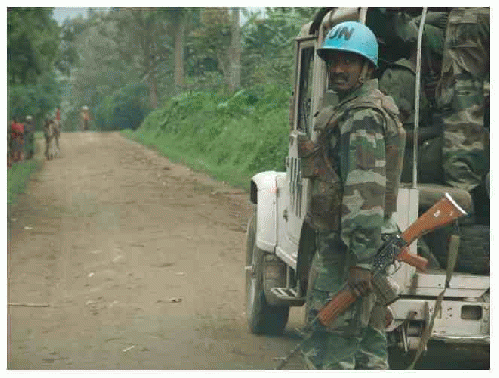WARNING of GRAPHIC CONTENT before you continue reading. I have gone round and round all day whether or not to include gruesome photos of the gorilla mutilations in Congo.I personally feel that it is an affront to the sentient nature of the gorillas to exploit their deaths in any manner. However, a bunch of guys, led by an under-staffed and under-funded group of UN soldiers risked their lives the other day to get documentation out to the world about what exactly happened in the Virungas this week. I have chosen the mildest gorilla photo I have. This is a community. Weigh in on whether I should take it down or not. Please note at end of article where you can send assistance to the brave men who are trying to protect this world heritage.
Goma, DRC (Imari and Frankfurt Zoological Society) January 17, 2007--The news from the heart of the habitat of the critically endangered mountain gorilla went from bad to hellish this week. Rebel soldiers commanded by dissident general, Laurent Nkunda, shot and killed a silverback Mountain Gorilla in the Southern Sector of Virunga National Park in the eastern Democratic Republic of Congo (DRC) on the fifth of January. The killing occurred less than 600 meters from a patrol post at Bikenge, which was recently abandoned following rebel attacks by forces loyal to Nkunda. No sooner had Robert Muir of the Frankfurt Zoological Society (FZS) and warden Paulin Ngobobo arranged for United Nations support to cross into rebel territory and retrieve the remains, when word reached them that there had been one and possibly another gorilla killing.
Paulin Ngobobo is the chief Warden for the Southern Sector of Virunga Park in DRC.
"Some of our rangers who live near Bikenge reported that new gorilla remains were found," he said. "Villagers reported that its body was cut up and shoved down a pit latrine. This terrible act was also done to humans during the Rwandan genocide. If this is the case, I suspect this gorilla was probably from the habituated group Mapua - in which case there could be others." The Mapua group of gorillas is located in the Mount Mikeno section of Virunga National Park, which straddles the boundaries of Uganda, Rwanda and DRC.
Rebel leader Nkunda is a former officer in the Congolese army who has been charged with war crimes and whose rebel forces have renewed military operations in eastern DRC. He fought with the Rwandan Patriotic Front, the rebel movement formed by Rwandan Tutsi exiles, which took control of Rwanda in 1994. Nkunda returned to DRC, where he was a commander in the Rally for Congolese Democracy (RCD) during the five-year civil war, and has since refused to join the integrated Congolese army.
Muir maintains that communication with the rebel forces is critical. " We need to impress on him (Nkunda) that even during times of conflict, it is inexcusable to destroy national and indeed world heritage of such critical value."
Despite a successful democratic national election in 2006, and tremendous natural and economic resources, DRC remains at the center of what has been termed Africa's World War. Its human population remains in the grips of constant humanitarian crises. The relentless conflict has put both humans and wildlife at extreme risk and threatened some of the most exotic species in the world.
Realizing that there would be no chance to stop future gorilla killings without an agreement from high in the rebel command structure, Muir and Ngobobo set off at dawn on Tuesday, along with six rangers and two MONUC patrol vehicles. MONUC is the peacekeeping force of the United Nations in the DRC. Established by the United Nations in 1999, the mission of MONUC includes the protection of civilians and the improvement of security conditions.
The MONUC battalion commander arranged clearance for entrance into the rebel-occupied areas to talk to Nikunda's men about the gorilla killings. According to Warden Ngobobo, six Congolese soldiers (FARDC) joined them as they attempted to make contact with rebel forces at Bikenge-the location of the original gorilla killing. At the edge of the FARDC control zone the Congolese militia were obliged to exit the MONUC vehicle, which continued on with Muir, Ngobobo and the MONUC escort. The group was literally entering no-man's land. On the left were Nikunda's rebel positions, and on the right of the otherwise beautiful valley were the regular army positions. There was no option but to cross the no-man's land that stretched between.
To make matters worse, the radio crackled with the news that a previous message to the rebel leader Nkunda had not been delivered. Having no idea how the rebels would interpret this intrusion along the edge of their territory, Muir and Ngobobo decided to press on and cautiously entered the valley.
The group passed within 250 meters of a rebel camp and it was "obvious the troops were surprised to see us there," Ngobobo said on his blog. A line of trees was immediately ahead, which indicated that Bikenge was just beyond the next hill. However, the site where the gorilla's remains were discarded would be 500 meters beyond the abandoned Bikenge station.
According to Muir, with their destination within site and reach, suddenly 20 soldiers appeared who were rapidly pacing down the hillside. Knowing that the message about their intentions had never reached Nkunda's command post, Ngobobo and Muir decided to move out and retreated to a position a few kilometers away. They considered themselves lucky that the soldiers they encountered were on foot.
Anticipating a negative outcome with the rebel forces, a backup plan had been put into place the day before and trackers were sent in to scout the area and try to retrieve the slaughtered gorilla's head. Ngobobo said on his blog, "It was a terrible thing to see, for many reasons."
"We did this because we needed to identify the individual, and to bring back irrefutable proof that gorillas were being killed. We've learned a lot. The gorilla had in fact been eaten for meat, his name was Karema, another solitary silverback that had been born into a habituated group, meaning that he had grown to trust humans enough to let them come to within touching distance. Above all, we learned that the remaining gorillas are extremely vulnerable - the rebels are after the meat, and it's not difficult for them to find and kill the few gorillas that remain."
The grisly task of cleaning and inspecting Karema's remains fell to Muir after returning to the relative safety of Rumangabo. This was a gorilla he knew, a lone silverback that had become so accustomed to humans that he would allow himself to be approached and touched. Tourism does generate income for the local communities, but it is the proverbial double-edged sword. The support of local communities is one reason that the gorilla ranger force has been able to protect the animals, but a habituated gorilla is extremely trusting, and does not stand a chance against poachers.
In an email on Wednesday, Muir confirmed that the patrol post at Bikenge was abandoned. Apparently the rebels were aware that Muir and his team would return to the site where the first gorilla died. "We did make it to the site today (Wednesday) where the gorilla had been shot and saw the drop pit that it's remains had been discarded in. The skin was lying there, the hair still silver", Muir reported.
Something positive did come out of a second visit into the zone under rebel control. Muir had a chance encounter with the new Indian Battalion Commander for MONUC, who agreed to arrange an official meeting for he rangers with the commander of the rebel brigade currently occupying the gorilla habitat.
The UN has also agreed to carry out a number of mixed patrols (MONUC Peacekeepers and the ICCN rangers) into the gorilla sector to try and locate the habituated groups. This will allow Muir and Ngobobo to establish the status of the habituated groups and determine whether or not other gorillas have also been shot and killed.
The Congolese military commander informed Muir that while the area that lies outside the park is now under his control, the entire gorilla sector is in the hands of Nkunda's rebel troops.
"Having confirmed that the gorillas are being eaten, the groups that have been habituated for tourism are now at extreme risk, Muir said.
Only 700 mountain gorillas remain worldwide, and their numbers have been proportionately drastically reduced by the DRC killings. Local communities rely upon the income generated by tourism revenues, as well-heeled tourists will pay handily to view and photograph the gentle animals.
Ngobobo's rangers have continued their work without interruption throughout the war, and during that time the gorilla population has increased by over 14 percent, or approximately 98 individuals. These numbers have come at great human cost, since 97 of Virunga's rangers on both sides of the Congolese/Rwandan border have died protecting the park's wildlife against poachers since 1996.
For more Information:
In United States: Georgianne Nienaber
Imari, Inc
218.831.5008
info@thelegacyofdianfossey.com
In DRC: Robert Muir
Project Leader and Country Representative
Frankfurt Zoological Society
Goma, Democratic Republic of Congo
Email: robertmuir@fzs.org
Website: www.zgf.de
Blog:
http://www.wildlifedirect.org/congo-rangers
http://www.wildlifedirect.org/gorillaprotection
####
GON






